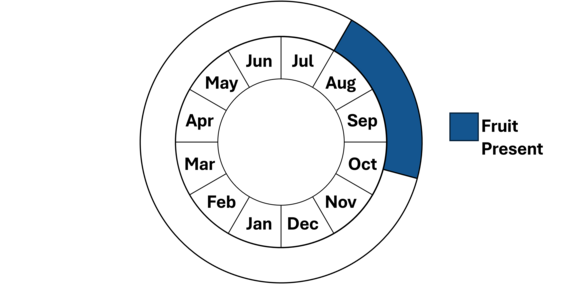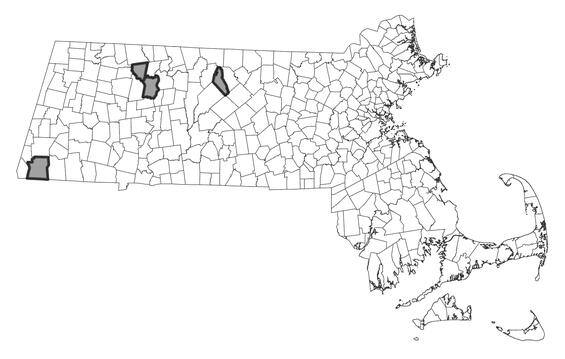- Scientific name: Chenopodium foggii
- Species of Greatest Conservation Need (MA State Wildlife Action Plan)
- Endangered (MA Endangered Species Act)
Description
Fogg’s goosefoot (Chenopodium foggii) is a globally rare annual herb of the goosefoot family (Chenopodiaceae) known to inhabit open, dry habitats. It has alternate, narrow, egg-shaped leaves and spikes of very small whitish flowers.
Fogg’s goosefoot grows 10-100 cm (8-40 in) in height, with alternately-arranged narrow egg-shaped leaves that have one to a few variable teeth near the base. The leaves are 1-4 cm (0.4-1.5 in) long and 5-18 mm (0.2-0.7 in) wide. The flowers are very small, with five whitish, mealy, keeled sepals born on short spikes. The sepals mostly conceal the fruit, and they mature uniformly. The fruit, a utricle, is small, thin-walled, one-seeded, and inflated, with small spines (the fruit is echinate), and an outer layer that separates easily from the seed.
Fogg’s goosefoot resembles other goosefoot species of Massachusetts, thus a technical key should be consulted to confirm identification. One very similar species, white pigweed (C. pratericola) differs subtly in leaf characteristics; white pigweed has leaves that are linear to lanceolate and less than 0.7-0.9 cm (~0.3 in) in width, whereas the leaves of Fogg’s goosefoot are narrow-ovate and greater than 1 cm (0.4 in) wide.

Population status
Fogg’s goosefoot is listed under the Massachusetts Endangered Species Act as Endangered. All listed species are legally protected from killing, collection, possession, or sale, and from activities that would destroy habitat and thus directly or indirectly cause mortality or disrupt critical behaviors. The MassWildlife’s Natural Heritage & Endangered Species Program database has 8 records from 5 counties: Berkshire, Franklin, Hampden, Middlesex, and Worcester. Four of these records have been observed within the last 25 years.
Distribution and abundance
The range of Fogg’s goosefoot is from Ontario and Quebec south to Massachusetts, New York, and Pennsylvania, with disjunct populations in the Midwest, Virginia, and North Carolina. It is also rare in Maine, New Hampshire, Pennsylvania, Vermont, Ontario, and Quebec.

Distribution in Massachusetts
1999-2024
Based on records in the Natural Heritage Database
Habitat
In Massachusetts, Fogg’s goosefoot inhabits dry soils of open woodlands, edges, and sunny rocky outcrops, over circumneutral or calcareous bedrock. Associated plant species include wild columbine (Aquilegia canadensis), black raspberry (Rubus occidentalis), little bluestem (Schizachyrium scoparium), cliff-fern (Woodsia obtusa), lace-grass (Eragrostis capillaris), and American pennyroyal (Hedeoma pulegioides).
Healthy habitats are vital for supporting native wildlife and plants. Explore habitats and learn about conservation and restoration in Massachusetts.
Threats
Fogg’s goosefoot requires partial sun exposure. Therefore, forest maturation and canopy closure, resulting from a lack of natural or anthropogenic disturbance, often casts too much shade. Also, invasive exotic plant species may over-shade or out-compete Fogg’s goosefoot at some sites. Fogg’s goosefoot habitat that is proximate to recreational trails may be threatened by trampling and erosion, or by damage from trail maintenance activities.
Conservation and management
As with many rare species, the exact management needs of Fogg’s goosefoot are not known. Sites should be monitored for over-shading caused by habitat succession, and for invasive plant species. Habitat sites that do not receive enough light can be managed with canopy thinning or prescribed burning. If trampling or erosion are threats in recreational areas, trails can be stabilized or re-routed. To avoid inadvertent harm to rare plants, all active management of rare plant populations (including invasive species removal) should be planned in consultation with MassWildlife’s Natural Heritage &Endangered Species Program.
Contact
| Date published: | April 10, 2025 |
|---|